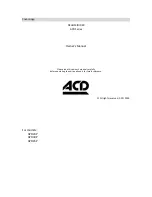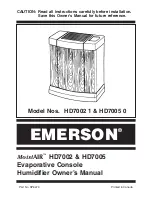
www.poolpak.com | 800-959-7725
54
| ComPak
®
Series - Installation, Operation and Maintenance
CPCS-PCP Network Operation
Networked CPCS-PCP units operate in a MASTER/SLAVE environment. This means that one unit (master)
determines heating, cooling, and dehumidification requirements and broadcasts them on the network to
the other units (slaves). This ensures that all units work together instead of against other. Each networked
unit contains all sensor and controls necessary for independent operation and is capable of acting in the
master role. Units on the network are identified by a number between one and four. The unit with the lowest
identification number having no uncleared alarms will be the master unit.
If an alarm condition occurs in the master unit, it will give up the role of master. The unit with the next lowest
identification number and no unclear alarms will take over the master role. The unit that experienced the alarm
condition will operate in the slave role until the alarm is cleared at the control panel.
A single control panel is used to monitor all units on the network. Starting with detailed status screen 5 to
identify the unit currently being monitored, Press and hold the `esc’ key and use the `up arrow’ key to get to
the next unit. Return to detailed status screen 5 to verify that the correct unit has been chosen. For the standard
configuration, all set points can be changed while the remote interface unit is displaying any unit. The set point
is automatically updated in every unit on the network. Other configurations may require the remote interface
unit to be displaying a particular unit to change the set point.
Figure 5-13. Unit Present Screen
The control panel provides two network status screens. These can be accessed in the detailed status menu.
The figure above shows the first screen that displays the status of units one through four as present or not. Use
this screen to verify that all units on the network are connected and communicating with each other. The figure
below shows the second screen that displays network information for the unit that is being displayed by the
remote interface unit, including network role, connection status and network identification number.
Network Configuration
Using the following four parameters, it is possible to configure the CPCS-PCP network to accommodate a wide
variety of installation options. Network configuration can be accessed in the service menu in MultiUnit Network.
These parameters must be set in each unit individually. Default values are shown in bold type.
POOL WATER TEMPERATURE CONTROL - LOCAL OR NETWORK.
Determines whether the unit will control water temperature based on the master’s command (NETWORK) or
its own temperature sensor and set point (LOCAL). If a unit set to LOCAL becomes the master, other units in the
network will not use the master’s command for water heating. They will look to the next line that is not set to
LOCAL. This parameter is only set to LOCAL if the unit is connected to a different pool than the rest of the units
on the network. Because the unit is controlling water temperature on its own, it is necessary to select the correct
unit with the control panel before changing the water temperature set point.
STAGED DEHUMIDIFICATION CONTROL - YES OR NO
Determines whether the unit will run in dehumidification when there is a need for 1 stage or 2 stages of
dehumidification. The master unit will start on any need for dehumidification independent of this parameter.
Slave units with this parameter set to YES will dehumidify only if the master is asking for 2 stages of
dehumidification. Setting this parameter to NO will cause the unit to dehumidify when the master calls for at
least 1 stage of dehumidification. Using this parameter, it is possible to configure the number of units in each
dehumidification stage.
















































